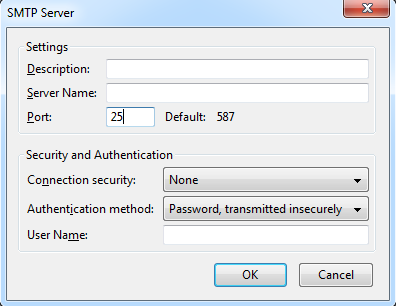When setting up your email client, you need to have the correct SMTP server settings as specified by your email provider to keep your email account working properly. SMTP (Simple Mail Transfer Protocol) settings are used for your outgoing mail server which is essential for successfully sending emails.
TABLE OF CONTENTS
Understanding SMTP Server Settings
SMTP is the standard communication protocol used to send emails from a client (Gmail, Apple Mail, etc.). SMTP is responsible for the entire delivery process from your mail client to the recipient’s mail server. It defines how email clients and mail servers communicate to send messages over the internet.
How SMTP Works
- Your email client uses SMTP to send your message to your email provider’s outgoing mail server. This involves authenticating with the server and submitting the message.
- Your email provider’s mail server uses SMTP to send the message to the recipient’s mail server.
- The recipient’s mail server (which also uses SMTP) receives and delivers the message to their inbox.
Recommended SMTP Server Settings
Correctly configuring your SMTP settings (server address, port, authentication) is essential for successful email delivery and ensures that your messages can be properly routed and delivered to the intended recipients. Here are the main settings to be aware of:
- SMTP Server Address: This is the address of your email provider’s outgoing mail server, for example, “smtp.gmail.com”. Your email provider will provide this information.
- Authentication: Almost all email providers require you to authenticate with your email account’s username and password to use their SMTP server.
- Ports: 587 is the recommended port for most providers or use port 465 if your provider specifically requires SSL/TLS from the start of the connection.
- Encryption: Always use encryption: Choose STARTTLS or SSL/TLS in your email client’s settings. This protects your login credentials and email content.
Note: Avoid port 25 if possible as many ISPs now block or restrict it due to its association with spam.

If you are not sure about what the correct SMTP settings for your outgoing mail server are or experience difficulties, it is advisable to contact your email provider’s support team for help.
Additional Information
Troubleshooting Common Issues
If you encounter issues when sending emails after setting up your SMTP server configurations, the following troubleshooting tips may help rectify them:
- Check Internet Connectivity: Confirm your internet connection is up and stable before sending emails.
- Review Email Client Configurations: Carefully examine all settings within your email client to ensure they align with the details provided by your email provider.
- Firewalls and Antivirus Software: Sometimes your firewalls or antivirus software can affect outgoing connections. Temporarily disabling these programs can help identify if they are the source of the problem.
- Experiment with Alternative Email Clients: If issues continue, consider using a different email client to see if the problem is with the one you are using.
Advantages of Using an Email Provider’s SMTP Server
Although using your ISP’s SMTP server may be convenient, it is advisable to consider the use of an email provider’s SMTP server like Gmail or Outlook)for improved functionalities, including:
Reliability: Email providers provide the infrastructure to ensure high deliverability rates and reduce the chances of your messages being flagged as spam. This includes managing sender reputation, authentication, and email compliance standards.
Stronger Authentication: Email providers enforce authentication by requiring a username and password and often support additional security like two-factor authentication (2FA). This helps protect your account from unauthorized access data theft.
Encryption: Email providers prioritize secure connections using encryption protocols like TLS (Transport Layer Security), protecting your content and login credentials during transfer.
IMAP Access: Most email providers offer IMAP (Internet Message Access Protocol) access, allowing you to synch your emails across multiple devices.
Advanced Features: Email providers often offer features such as spam filtering, virus scanning, organization tools, mobile apps, and integration with other services like contacts and calendars.




















